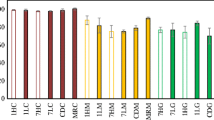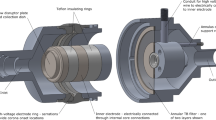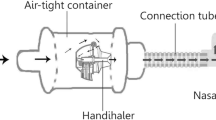Abstract
Purpose. The purpose of this study was to analyze a diffusion dryer as a means to remove organic solvents from aerosol particles of poorly water soluble drugs.
Methods. Aerosols of methanol, ethanol, and ethyl acetate were generated with an ultrasonic nebulizer, and inflow to outflow concentration ratio of vapor in a annular charcoal column was determined as a function of time by gas chromotography at two to four different airflow rates. In addition, the particle transmission efficiency was determined with an ethanol solution of the test compound, budesonide. The results were analyzed with equations originally developed for assessing the loss of drug from intravenous tubing along with independent measures of the adsorption isotherm of the vapors onto charcoal.
Results. Aerosol production was relatively constant with time, and the transmission of solid particles through the column occurred with efficiency nearing 100%. The inlet to outlet vapor concentration ratio was adequately described by a model of three resistances in series composed of the inner tube, the screen mesh, and the charcoal bed.
Conclusions. The diffusion dryer was found to be satisfactory for the removal of methanol, ethanol, and ethyl acetate and the efficiency may be assessed from the adsorption isotherms on charcoal and the geometry of the dryer.
Similar content being viewed by others
REFERENCES
L. W. Wattenberg, T. S. Wiedmann, R. D. Estensen, C. L. Zimmerman, V. E. Steele, and G. J. Kelloff. Chemoprevention of pulmonary carcinogenesis by aerosolized budesonide in female A/J mice. Cancer Res. 57:5489-5492 (1997).
L. W. Wattenberg. Prevention-therapy-basic science and the resolution of the cancer problem: Presidential address. Cancer Res. 53:5890-5896 (1993).
J. Heyder, J. Gebhart, G. Rudolf, C. F. Schiller, and W. Stahlhofen. Deposition of particles in the human respiratory tract in the size range of 0.005–15 microns. J. Aerosol Sci. 17:811-825 (1986).
P. G. Gormley and M. Kennedy, Diffusion from a stream flowing through a cylindrical tube. Proc. Royal Irish Academy A52, 1997-2002 (1949).
M. S. Roberts. Modeling solute sorption into plastic tubing during organ perfusion and intravenous infusions. J. Pharm. Sci. 85:65-665 (1996).
A. B. Cambel and J. B. Fenn. “Transport Properties in Gases,” University Press: New York (1958).
T. T. Mercer, R. F. Goddard, and R. L. Flores. Output characteristics of three ultrasonic nebulizers. Annal Allergy 26:18-27 (1968).
W. C. Hinds. “Aerosol Technologies: Properties, Behavior, and Measurement of Airborne Particles,” John Wiley & Sons, New York, 1982.
R. L. Elliot, G. L. Amidon, and E. N. Lightfoot. A convective mass transfer model for determining intestinal wall permeabilityies: laminar flow in a circular tube. J. Theor. Biol. 87:757-771 (1980).
J. Timmermans. Physico-chemical constants of pure organic compounds, Elsevier Publishing Co., New York (1950).
D. R. Lide. CRC handbook of Chemistry and Physics, 73rd edition, CRC Press, Ann Arbor, MI, (1992).
Author information
Authors and Affiliations
Corresponding author
Rights and permissions
About this article
Cite this article
Pham, S., Wiedmann, T.S. Analysis of a Diffusion Dryer for the Respiratory Delivery of Poorly Water Soluble Drugs. Pharm Res 16, 1857–1863 (1999). https://doi.org/10.1023/A:1018903426344
Issue Date:
DOI: https://doi.org/10.1023/A:1018903426344




